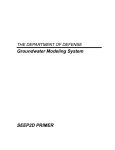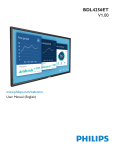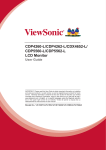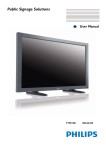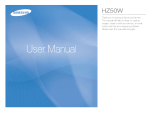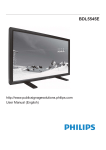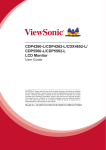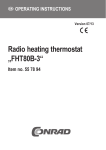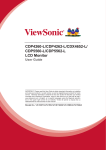Download AG Neovo PS-55
Transcript
PS-Series LED-Backlit Display
User Manual
TABLE OF CONTENTS
SAFETY INFORMATION...................................................................................................... 4
REGULATORY INFORMATION............................................................................................ 6
CHAPTER 1: UNPACKING AND INSTALLATION............................................................. 11
1.1.
1.2.
1.3.
1.4.
Unpacking........................................................................................................................ 11
Package Contents........................................................................................................... 11
Installation Notes............................................................................................................. 11
Installing and Removing Table Stands (optional)............................................................. 12
1.4.1. To install table stands........................................................................................... 12
1.4.2. To remove table stands........................................................................................ 12
1.5. Mounting on a Wall.......................................................................................................... 13
1.5.1. VESA Grid............................................................................................................ 13
1.5.2. Ventilation Requirements for enclosure locating.................................................. 14
CHAPTER 2: PARTS AND FUNCTIONS........................................................................... 15
2.1. Control Panel................................................................................................................... 15
2.2. Input/Output Terminals..................................................................................................... 17
2.3. Remote Control................................................................................................................ 18
2.3.1 General functions................................................................................................. 18
2.3.2 Inserting the batteries in the remote control......................................................... 19
2.3.3 Handling the remote control................................................................................. 20
2.3.4 Operating range of the remote control.................................................................. 20
CHAPTER 3: CONNECTING EXTERNAL EQUIPMENT................................................... 21
3.1 Using the Switch Cover................................................................................................... 21
3.2 Connecting External Equipment (DVD/VCR/VCD).......................................................... 21
3.2.1 Using COMPONENT video input.......................................................................... 21
3.2.2 Using HDMI video input........................................................................................ 22
3.3 Connecting a PC.............................................................................................................. 22
3.3.1 Using VGA input................................................................................................... 22
3.3.2 Using DVI input..................................................................................................... 23
3.3.3 Using HDMI input................................................................................................. 23
3.4 Connecting Audio Equipment.......................................................................................... 24
3.4.1 Connecting external speakers.............................................................................. 24
3.4.2 Connecting an external audio device................................................................... 24
3.5 Connecting Multiple Displays in a Daisy-chain Configuration.......................................... 25
3.5.1 Display control connection.................................................................................... 25
3.5.2 Digital video connection........................................................................................ 25
3.5.3 Analog video connection...................................................................................... 25
CHAPTER 4: OSD MENU................................................................................................... 26
4.1 Navigating the OSD Menu.............................................................................................. 26
4.1.1 Navigating the OSD menu using the remote control............................................ 26
4.1.2 Navigating the OSD menu using the display’s control buttons............................. 26
2
TABLE OF CONTENTS
4.2 OSD Menu Overview....................................................................................................... 27
4.2.1 PICTURE menu.................................................................................................... 27
4.2.2 SCREEN menu..................................................................................................... 28
4.2.3 AUDIO menu........................................................................................................ 31
4.2.4 PIP menu.............................................................................................................. 31
CHAPTER 5: INPUT MODE............................................................................................... 42
5.1 VGA Resolution............................................................................................................... 42
5.2 SDTV Resolution............................................................................................................. 42
5.3 HDTV Resolution............................................................................................................. 42
CHAPTER 6: CLEANING AND TROUBLESHOOTING..................................................... 44
6.1 Cleaning........................................................................................................................... 44
6.2 Troubleshooting............................................................................................................... 45
CHAPTER 7: TECHNICAL SPECIFICATIONS.................................................................. 47
7.1 Display Specifications...................................................................................................... 47
3
SAFETY INFORMATION
SAFETY INFORMATION
Warnings and Precautions
KNOW THESE SAFETY SYMBOLS
CAUTION:TO REDUCE THE RISK OF ELECTRIC SHOCK, DO NOT REMOVE COVER
(OR BACK). NO USER SERVICEABLE PARTS INSIDE. REFER SERVICING TO
QUALIFIED SERVICE PERSONNEL.
This symbol indicates high voltage is present inside. It is dangerous to make any kind
of contact with any inside part of this product.
This symbol alerts you that important literature concerning operation and maintenance
has been included with this product.
Note to CATV system installer: This reminder is provided to call CATV system installer’s attention
to Article 820-40 of the National Electrical Code (Section 54 of Canadian Electrical Code, Part I),
that provides guidelines for proper grounding and, in particular, specifies that the cable ground
shall be connected to the grounding system of the building as close to the point of cable entry as
practical.
CAUTION:FCC/CSA regulations state that any unauthorized changes or modifications to this
equipment may void the user’s authority to operate it.
CAUTION:To prevent electric shock, match the wide blade of plug to the wide slot, and fully insert
the plug.
IMPORTANT:One Federal Court has held that unauthorized recording of copyrighted TV programs
is an infringement of U.S. copyright laws. Certain Canadian programs may also be
copyrighted and any unauthorized recording in whole or in part may be in violation
of these rights.
TO PREVENT DAMAGE WHICH MAY RESULT IN FIRE OR ELECTRIC SHOCK HAZARD, DO
NOT EXPOSE THIS APPLIANCE TO RAIN OR MOISTURE.
The Socket-outlet shall be installed near the apparatus and shall be easily accessible.
4
SAFETY INFORMATION
Read and follow follow these instructions when connecting and using your Public
Information Display:
•• Unplug the display if you are not going to use it for an extensive period of time.
•• Unplug the display if you need to clean it with a slightly damp cloth. The screen
many be wiped with a dry cloth when the power is off. However, never use alcohol,
solvents or ammonia-based liquids.
•• Consult a service technician if the display does not operate normally when you
have followed the instructions in this manual.
•• The casing cover should be opened only by qualified service personnel.
•• Keep the display out of direct sunlight and away from stoves or any other heat
sources.
•• Remove any object that could fall into the vents or prevent proper cooling of the
display’s electronics.
•• Do not block the ventilation holes on the cabinet.
•• Keep the display dry. To avoid electric shock, do not expose it to rain or excessive
moisture.
•• If turning off the display by detaching the power cable, wait for 6 seconds before
re-attaching the power cable or DC power cord for normal operation.
•• To avoid the risk of shock or permanent damage to the set do not expose the
display to rain or excessive moisture.
•• When positioning the display, make sure the power plug and outlet are easily
accessible.
•• IMPORTANT: Always activate Anti-Burn-in during your application. If a still image
in high contrast remains on the screen for an extended period of time, it may leave
an ‘after-image’ or ‘ghost image’ on the front of the screen. This is a well-known
phenomenon that is caused by the shortcomings inherent in LCD technology. In
most cases the afterimage will disappear gradually over a period of time after the
power has been switched off. Be aware that the after-image symptom cannot be
repaired and is not covered under warranty.
5
REGULATORY INFORMATION
REGULATORY INFORMATION
CE Declaration of Conformity
We declare under our responsibility that the product is in conformity with the following standards:
•• EN60950-1:2006 (Safety requirement of Information Technology Equipment)
•• EN55022:2006+A1:2007 (Radio Disturbance requirement of Information Technology Equipment)
•• EN55024:1998+A1:2001+A2:2003 (Immunity requirement of Information Technology
Equipment)
•• EN61000-3-2:2006 (Limits for Harmonic Current Emission)
•• EN61000-3-3:2008 (Limitation of Voltage Fluctuation and Flicker) following provisions of
directives applicable
•• 2006/95/EC (Low Voltage Directive)
•• 2004/108/EC (EMC Directive)
•• 2005/32/EC (ErP, Energy-related Product Directive) EC No. 642/2009 Implementing
•• 93/68/EEC (Amendment of EMC and Low Voltage Directive) and is produced by a
manufacturing organization on ISO9000 level.
Federal Communications Commission (FCC) Notice (U.S. Only)
This equipment has been tested and found to comply with the limits for a Class B
digital device, pursuant to Part 15 of the FCC Rules. These limits are designed to
provide reasonable protection against harmful interference when the equipment is
operated in a commercial environment. This equipment generates, uses and can
radiate radio frequency energy and, if not installed and used in accordance with
the instructions manual, may cause harmful interference to radio communications.
Operation of this equipment in a residential area is likely to cause harmful interference
in which case the user will be required to correct the interference at his own expense.
Changes or modifications not expressly approved by the party responsible for
compliance could void the user’s authority to operate the equipment.
Use only RF shielded cable that was supplied with the display when connecting this display to a
computer device.
To prevent damage which may result in fire or shock hazard, do not expose this appliance to rain
or excessive moisture.
THIS CLASS B DIGITAL APPARATUS MEETS ALL REQUIREMENTS OF THE CANADIAN
INTERFERENCE- CAUSING EQUIPMENT REGULATIONS.
This device complies with Part 15 of the FCC Rules. Operation is subject to the
following two conditions: (1) this device may not cause harmful interference, and (2)
this device must accept any interference received, including interference that may
cause undesired operation.
6
REGULATORY INFORMATION
Polish Center for Testing and Certification Notice
The equipment should draw power from a socket with an attached protection circuit (a three-prong
socket). All equipment that works together (computer, monitor, printer, and so on) should have the
same power supply source.
The phasing conductor of the room’s electrical installation should have a reserve short-circuit
protection device in the form of a fuse with a nominal value no larger than 16 amperes (A).
To completely switch off the equipment, the power supply cable must be removed from the power
supply socket, which should be located near the equipment and easily accessible.
A protection mark “B” confirms that the equipment is in compliance with the protection usage
requirements of standards PN-93/T-42107 and PN-89/E-06251.
Electric, Magnetic and Electronmagnetic Fields (“EMF”)
111 We manufacture and sell many products targeted at consumers, which, like any electronic
apparatus, in general have the ability to emit and receive electromagnetic signals.
222 One of our leading Business Principles is to take all necessary health and safety measures for
our products, to comply with all applicable legal requirements and to stay well within the EMF
standards applicable at the time of producing the products.
333 We are committed to develop, produce and market products that cause no adverse health
effects.
444 We confirm that if its products are handled properly for their intended use, they are safe to use
according to scientific evidence available today.
555 We play an active role in the development of international EMF and safety standards, enabling
us to anticipate further developments in standardization for early integration in its products.
7
REGULATORY INFORMATION
Information for U.K. only
WARNING - THIS APPLIANCE MUST BE EARTHED.
IMPORTANT: This apparatus is supplied with an approved
moulded 13A plug. To change a fuse in this type of plug
proceed as follows:
111 Remove fuse cover and fuse.
222 Fit new fuse which should be a BS 1362 5A,A.S.T.A. or
BSI approved type.
333 Refit the fuse cover.
If the fitted plug is not suitable for your socket outlets, it
should be cut off and an appropriate 3-pin plug fitted in its
place.
If the mains plug contains a fuse, this should have a value of
5A. If a plug without a fuse is used, the fuse at the distribution
board should not be greater than 5A.
NOTE: The severed plug must be destroyed to avoid a
possible shock hazard should it be inserted into a
13A socket elsewhere.
How to connect a plug:
The wires in the mains lead are coloured in accordance with the following code:
BLUE - “NEUTRAL” (“N”)
BROWN - “LIVE” (“L”)
GREEN & YELLOW - “EARTH” (“E”)
111 The GREEN & YELLOW wire must be connected to the
terminal in the plug which is marked with the letter “E” or
by the Earth symbol or coloured GREEN or GREEN &
YELLOW.
222 The BLUE wire must be connected to the terminal which is
marked with the letter “N” or coloured BLACK.
333 The BROWN wire must be connected to the terminal
which marked with the letter “L” or coloured RED.
Before replacing the plug cover, make certain that the cord
grip is clamped over the sheath of the lead - not simply over
the three wires.
8
(B)
(A)
REGULATORY INFORMATION
North Europe (Nordic Countries) Information
Placering/Ventilation
VARNING: FÖRSÄKRA DIG OM ATT HUVUDBRYTARE OCH UTTAG ÄR LÄTÅTKOMLIGA,
NÄR DU STÄLLER DIN UTRUSTNING PÅPLATS.
Placering/Ventilation
ADVARSEL: SØRG VED PLACERINGEN FOR, AT NETLEDNINGENS STIK OG
STIKKONTAKT ER NEMT TILGÆNGELIGE.
Paikka/Ilmankierto
VAROITUS: SIJOITA LAITE SITEN, ETTÄ VERKKOJOHTO VOIDAAN TARVITTAESSA
HELPOSTI IRROTTAA PISTORASIASTA.
Plassering/Ventilasjon
ADVARSEL: NÅR DETTE UTSTYRET PLASSERES, MÅ DU PASSE PÅ AT KONTAKTENE
FOR STØMTILFØRSEL ER LETTE Å NÅ.
End-of-Life Disposal
Your new Public Information Display contains materials that can be recycled and reused.
Specialized companies can recycle your product to increase the amount of reusable materials and
to minimize the amount to be disposed of.
Please find out about the local regulations on how to dispose of your old display from your local
dealer.
Waste Electrical and Electronie Equipment-WEEE
Attention users in European Union private households
This marking on the product or on its packaging illustrates that, under European
Directive 2002/96/EG governing used electrical and electronic appliances, this
product may not be disposed of with normal household waste. You are responsible
for disposal of this equipment through a designated waste electrical and electronic
equipment collection. To determine the locations for dropping off such waste electrical
and electronic, contact your local government office, the waste disposal organization
that serves your household or the store at which you purchased the product.
9
REGULATORY INFORMATION
Attention users in United States:
Like all LCD products, this set contains a lamp with Mercury. Please dispose of according to
all Local, State and Federal Laws. For the disposal or recycling information, contact: www.
mygreenelectronics.com or www.eiae.org.
End of Life Directives-Recycling
Your new Public Information Display contains several materials that can be recycled
for new users.
Like all LCD produces, this set contains a lamp with Mercury. Please dispose of
according to all Local, State, and Federal laws.
10
CHAPTER 1: UNPACKING AND INSTALLATION
CHAPTER 1: UNPACKING AND INSTALLATION
11111 Unpacking
••
••
••
••
This product is packed in a carton, together with the standard accessories.
Any other optional accessories will be packed separately.
Due to the size and weight of this display it is recommended for two people to move it.
After opening the carton, ensure that the content is in good condition and complete.
11111 Package Contents
Please verify that you received the following items with your package content:
•• LCD display
•• CD
•• Remote control with AAA
batteries
•• Power cord (1.8 m)
•• VGA cable (1.8 m)
•• Power switch cover
•• Screw for Power switch
cover (M3x8)
•• Cable tie
POWER
SMART
VIDEO
SOURCE
ON/OFF
INPUT
AUDIO
SOURCE
PIP
CONTRAST
BRIGHTNESS
DISPLAY
Power switch cover
and screw (M3x8) x1
CHANGE
MENU
SET
AUTO
ADJUST
EXIT
VOL UP
MUTE
VOL DOWN
Video Signal Cable
(D-SUB to D-SUB Cable)
Remote Control
and AAA Batteries
CD ROM
Cable tie
Power Cord
NOTES:
• Please make sure that for all other regions, apply a power cord that conforms to the AC voltage
of the power socket and has been approved by and complies with the safety regulations of the
particular country.
• You might like to save the package box and packing material for shipping the display.
11111 Installation Notes
•• Due to the high power consumption, always use the plug exclusively designed for this product. If
an extended line is required, please consult your service agent.
•• The product should be installed on a flat surface to avoid tipping. The distance between the
back of the product and the wall should be maintained for proper ventilation. Avoid installing the
product in the kitchen, bathroom or any other places with high humidity so as not to shorten the
service life of the electronic components.
•• The product can normally operate only under 3000m in altitude. In installations at altitudes
above 3000m, some abnormalities may be experienced.
11
UNPACKING AND INSTALLATION
11111 Installing and Removing Table Stands (optional)
1111111 To install table stands
111 Ensure your display is powered off.
222 Spread a protective sheet on a flat surface.
333 Grab the carrying handles and place the display face-down on the protective sheet.
444 After inserting the stand in the guide block, tighten the screws on both sides of the display.
NOTE: The longer side of the stand should face the front of the display.
Carrying handle
Thumbscrews
Longer portions face the front
Table stand
1111111 To remove table stands
111 Power off the display.
222 Spread a protective sheet on a flat surface.
333 Grab the carrying handles and place the display face-down on the protective sheet.
444 Remove screws using a screwdriver and place them in a safe place for reuse.
12
UNPACKING AND INSTALLATION
11111 Mounting on a Wall
To mount this display to a wall, you will have to obtain a standard wall-mounting kit (commercially
available). We recommend using a mounting interface that complies with TUV-GS and/or UL1678
standard in North America.
400
Protective Sheet
400
200
400
200
200
Table
Tabletop stand
111 Lay a protective sheet on a table, which was wrapped around the display when it was packaged,
beneath the screen surface so as not to scratch the screen face.
222 Ensure you have all accessories for mounting this display (wall mount, ceiling mount, table
stand, etc).
333 Follow the instructions that come with the base mounting kit. Failure to follow correct mounting
procedures could result in damage to the equipment or injury to the user or installer. Product
warranty does not cover damage caused by improper installation.
444 For the wall-mounting kit, use M6 mounting screws (having a length 10 mm longer than the
thickness of the mounting bracket) and tighten them securely.
1111111 VESA Grid
PS-46
PS-55
400 (H) x 400 (V)
400 (H) x 200 (V)
200 (H) x 200 (V)
Caution:
To prevent the display from falling:
• For wall or ceiling installation, we recommend installing the display with metal brackets which
are commercially available. For detailed installation instructions, refer to the guide received with
the respective bracket.
• To lessen the probability of injury and damage resulting from fall of the display in case of
earthquake or other natural disaster, be sure to consult the bracket manufacturer for installation
location.
13
UNPACKING AND INSTALLATION
1111111 Ventilation Requirements for enclosure locating
To allow heat to disperse, leave space between surrounding objects as shown in the diagram
below.
100 mm
100 mm
100 mm
100 mm
14
CHAPTER 2: PARTS AND FUNCTIONS
CHAPTER 2: PARTS AND FUNCTIONS
22222 Control Panel
9
MUTE INPUT
1
1
2
3
MENU
4
5
6
7
8
POWER button
Use this button to turn the display on or put
the display to standby.
2
MUTE button
Switch the audio mute ON/OFF.
3
INPUT button
Use this button to select the input source.
4
[ ] button
•• Increase the adjustment while OSD menu
is on, or increase the audio output level
while OSD menu is off.
•• Used as [SET] button in the On-ScreenDisplay menu.
5
9
[ ] button
Decrease the adjustment while OSD menu is
on, or decrease the audio output level while
OSD menu is off.
6
[ ] button
Move the highlight bar up to adjust the
selected item while OSD menu is on.
7
[ ] button
Move the highlight bar down to adjust the
selected item while OSD menu is on.
8
MENU button
Return to previous menu while OSD menu is
on, or to activate the OSD menu when OSD
menu is off.
15
NOTE:“Keyboard Control Lock Mode”
This function completely disables
the access to all Keyboard Control
functions. To enable or disable the
keyboard control lock, press both [
] and [ ] buttons and hold down
continuously for more than 3 (three)
seconds.
Remote control sensor and power status
indicator
•• Receives command signals from the
remote control.
•• Indicates the operating status of the
display without OPS:
-- Lights green when the display is turned
on
-- Lights red when the display is in standby
mode
-- Lights amber when the display enters
APM mode
-- When {SCHEDULE} is enabled, the light
blinks green and red
-- If the light blinks red, it indicates that a
failure has been detected
-- Lights off when the main power of the
display is turned off
PARTS AND FUNCTIONS
•• Indicates the operating status of the display with OPS:
-- Lights green when the display is on, but the OPS is off
-- Lights blue when the display and the OPS is on
-- Lights red when the display is in standby mode
-- Lights amber when the display enters APM mode
-- When {SCHEDULE} is enabled, the light blinks green and red
-- If the light blinks red, it indicates that a failure has been detected
-- Lights off when the main power of the display is turned off
16
PARTS AND FUNCTIONS
22222 Input/Output Terminals
17
16
15
14
2
1
3
4 5
6
7 8
9 10
1
AC IN
AC power input from the wall outlet.
10 VGA
2
MAIN POWER SWITCH
Switch the main power on/off.
11 PC
3
RS232C OUT
RS232C network output for the loopthrough function.
4
5
RS232C IN
RS232C network input for the loop-through
function.
RJ-45
LAN port connection from your OPS device.
11
12 13
IN (D-Sub)
VGA video input.
AUDIO IN
Audio input for VGA/DVI source (3.5mm stereo
phone).
12 COMPONENT
IN (BNC)
Component YPbPr video source input.
13 SPEAKERS
SWITCH
Internal speaker on/off switch.
14 AUDIO
IN
Audio input from external AV device (RCA).
15 AUDIO
OUT (RCA)
Audio output from the AUDIO IN jack to an
external AV device.
6
HDMI IN
HDMI video/audio input.
7
DisplayPort
DisplayPort video input.
16 SPEAKERS
8
DVI IN
DVI-D video input.
17 KENSINGTON
9
DVI OUT / VGA OUT
DVI or VGA video output.
OUT
External speakers output.
LOCK
Used for security and theft prevention.
17
PARTS AND FUNCTIONS
22222 Remote Control
•• Standard: Used for normal images
(factory setting)
•• Highbright: Used for moving image such
as Video
•• sRGB: Used for text based images
POWER
1
3
10
SMART
VIDEO
SOURCE
AUDIO
SOURCE
2
11
12
PIP
3
4
ON/OFF
INPUT
CHANGE
4
13
CONTRAST
BRIGHTNESS
5
16
SET
7
8
17
AUTO
ADJUST
EXIT
VOL UP
9
5
MENU
DISPLAY
6
14
15
MUTE
2
[DISPLAY] button
Press to turn on/off the information OSD
displayed on the upper right corner of the
screen.
[ ] button
•• Press to move the selection left in OSD
menu.
•• Press to decrease the value in OSD
menu.
•• Press to move the sub-picture left in PIP
mode.
7 [SET] button
Press to activate the setting inside the OSD
menu.
8 [AUTO ADJUST] button
Press to run the Auto Adjust function.
NOTE:This button is functional for VGA
input only.
9 [MUTE] button
Press to turn the mute function on/off.
10 [VIDEO SOURCE] button
Press to toggle Video Source Menu. Press
[ ] or [ ] button to select one of the video
sources among DisplayPort, DVI-D, VGA,
HDMI, Component, Video, or Card OPS.
Press [SET] button to confirm and exit.
11 [AUDIO SOURCE] button
Press to toggle Audio Source Menu. Press
[ ] or [ ] button to select one of the
audio sources among DisplayPort, HDMI,
Audio1, Audio2, or Card OPS. Press [SET]
button to confirm and exit.
6
18
19
20
VOL DOWN
222222 General functions
1
[PIP] (Picture In Picture) button
[ON/OFF]:Turn PIP mode ON/OFF.
[INPUT]:Select the input signal for the subpicture.
[CHANGE]:Toggle between the main picture
and sub picture.
[CONTRAST] button
Press to activate Contrast Menu. Press [
] or [ ] button to adjust the value. Press
[MENU] button to confirm and exit.
[POWER] button
Press to switch on the display from standby
mode. Press again to turn it off and back into
standby mode.
[SMART] button
Press to activate Smart Menu. Press
[ ] or [ ] button to select menu options.
Press [SET] button to confirm and exit the
selection.
18
PARTS AND FUNCTIONS
12 Picture
Format button
Press to switch screen aspect ratio.
•• For PC signal: FULL, NORMAL, CUSTOM and REAL.
•• For Video signal: FULL, NORMAL, DYNAMIC, CUSTOM, REAL, and 21:9.
13 [BRIGHTNESS]
button
Press to toggle Brightness Menu. Press [ ] or [ ] button to adjust the value. Press [MENU]
button to confirm and exit.
14 [
] button
•• Press to move the selection up in OSD menu.
•• Press to move the sub-picture up in PIP mode.
15 [MENU]
button
Press to turn the OSD menu on/off.
16 [
] button
•• Press to move the selection right in OSD menu.
•• Press to increase the value in OSD menu.
•• Press to move the sub-picture right in PIP mode.
17 [EXIT]
button
Press to turn back to the previous OSD menu.
18 [
] button
•• Press to move the selection down in OSD menu.
•• Press to move the sub-picture down in PIP mode.
19 [VOL
UP] button
Press to increase the audio output level.
20 [VOL
DOWN] button
Press to decrease the audio output level.
222222 Inserting the batteries in the remote control
The remote control is powered by two 1.5V AAA batteries.
To install or replace batteries:
111 Press and then slide the cover to open it.
222 Align the batteries according to the (+) and (–) indications inside the battery compartment
333 Replace the cover.
19
PARTS AND FUNCTIONS
Caution:
The incorrect use of batteries can result in leaks or bursting. Be sure to follow these instructions:
• Place “AAA” batteries matching the (+) and (–) signs on each battery to the (+) and (–) signs of
the battery compartment.
• Do not mix battery types.
• Do not combine new batteries with used ones. It causes shorter life or leakage of batteries.
• Remove the dead batteries immediately to prevent them from liquid leaking in the battery
compartment. Don’t touch exposed battery acid, it can damage your skin.
NOTE: If you do not intend to use the remote control for a long period, remove the batteries.
222222 Handling the remote control
•• Do not subject to strong shock.
•• Do not allow water or other liquid to splash the remote control. If the remote control gets wet,
wipe it dry immediately.
•• Avoid exposure to heat and steam.
•• Other than to install the batteries, do not open the remote control.
222222 Operating range of the remote control
Point the top of the remote control toward the display’s remote control sensor when pressing a
button.
Use the remote control within a distance of less than 10m/33ft from the display’s sensor, and a
horizontal and vertical angle of less than 30 degrees.
NOTE:The remote control may not function properly when the remote control sensor on the
display is under direct sunlight or strong illumination, or when there is an obstacle in the
path of signal transmission.
30
30
POWER
SMART
VIDEO
SOURCE
AUDIO
SOURCE
PIP
ON/OFF
INPUT
CONTRAST
CHANGE
BRIGHTNESS
DISPLAY
MENU
SET
AUTO
ADJUST
EXIT
VOL UP
MUTE
VOL DOWN
20
CHAPTER 3: CONNECTING EXTERNAL EQUIPMENT
CHAPTER 3: CONNECTING EXTERNAL EQUIPMENT
3333 Using the Switch Cover
A cover for the power switch is provided to prevent the display from being turned on or off
accidentally.
To lock the cover into position:
111 Align and insert the cover to the indentation located beside the power switch.
222 Use the screw to lock the cover.
3333 Connecting External Equipment (DVD/VCR/VCD)
333333 Using COMPONENT video input
Audio Out
COMPONENT Out
(YPbPr)
[R]
[L]
DVD / VCR / VCD
[AUDIO IN]
[COMPONENT IN]
(YPbPr)
21
CONNECTING EXTERNAL EQUIPMENT
333333 Using HDMI video input
DVD / VCR / VCD
HDMI Out
[HDMI IN]
3333 Connecting a PC
333333 Using VGA input
VGA Out
D-Sub 15 pin
PC
[R]
Audio Out
[L]
[AUDIO IN]
22
[VGA IN]
[PC AUDIO IN]
CONNECTING EXTERNAL EQUIPMENT
333333 Using DVI input
DVI Out
PC
[R]
Audio Out
[L]
[AUDIO IN]
[DVI IN]
[PC AUDIO IN]
333333 Using HDMI input
HDMI Out
PC
[HDMI IN]
23
CONNECTING EXTERNAL EQUIPMENT
3333 Connecting Audio Equipment
333333 Connecting external speakers
External speakers
333333 Connecting an external audio device
Audio In
[R]
[L]
[AUDIO OUT]
24
Stereo Amplifier
CONNECTING EXTERNAL EQUIPMENT
3333 Connecting Multiple Displays in a Daisy-chain Configuration
You can interconnect multiple displays to create a daisy-chain configuration for applications such
as a video wall.
NOTE: Maximum 25 displays (5x5) can be used in a daisy-chain configuration.
333333 Display control connection
Connect the [RS232C OUT] connector of DISPLAY 1 to the [RS232C IN] connector of DISPLAY 2.
PC
[RS-232C]
DISPLAY 1
[RS-232C IN]
DISPLAY 2
[RS-232C OUT]
[RS-232C IN]
333333 Digital video connection
Connect the [DVI OUT / VGA OUT] connector of DISPLAY 1 to the [DVI IN] connector of DISPLAY 2.
PC
[DVI]
DISPLAY 1
[DVI IN]
DISPLAY 2
[DVI/VGA OUT]
[DVI IN]
333333 Analog video connection
Connect the [DVI OUT / VGA OUT] connector of DISPLAY 1 to the [VGA IN] connector of
DISPLAY 2.
PC
[VGA]
DISPLAY 1
[VGA IN]
DISPLAY 2
[DVI/VGA OUT]
25
[VGA IN]
CHAPTER 4: OSD MENU
CHAPTER 4: OSD MENU
An overall view of the On-Screen Display (OSD) structure is shown below. You can use it as a
reference for further adjusting your display.
4444 Navigating the OSD Menu
444444 Navigating the OSD menu using the remote control
MENU
SET
EXIT
111 Press [MENU] button on the remote control to display the OSD menu.
222 Press [ ] or [ ] button to choose the item you want to adjust.
333 Press [SET] button to enter the submenu.
444 In the submenu, press [ ] or [ ] button to toggle among items, press [ ] or [ ] button to adjust
settings. If there is a submenu, press [SET] button to enter the submenu.
555 Press [EXIT] button to return to the previous menu, or press [MENU] button to exit the OSD
menu.
444444 Navigating the OSD menu using the display’s control buttons
111 Press [MENU] button to display the OSD menu.
222 Press [ ] or [ ] button to choose the item you want to adjust.
333 Press [SOURCE] button to enter the submenu.
444 In the submenu, press [ ] or [ ] button to toggle among items, press [ ] or [ ] button to adjust
settings. If there is a submenu, press [SOURCE] button to enter the submenu.
555 Press [MENU] button to return to the previous menu, or press [MENU] button several times to
exit the OSD menu.
26
OSD MENU
4444 OSD Menu Overview
444444 PICTURE menu
PICTURE
1
2
PIP
BRIGHTNESS
CONTRAST
SHARPNESS
BLACK LEVEL
TINT
COLOR
COLOR TEMPERATURE
USER COLOR
GAMMA SELECTION
NOISE REDUCTION
FILM MODE
PICTURE RESET
70
50
50
50
NATIVE
NATIVE
3
:SEL
Item
BRIGHTNESS
SET :NEXT
EXIT
:RETURN
MENU :EXIT
MENU
SHARPNESS
Description
Adjust the overall image brightness by changing the intensity of the LCD
panel’s backlight.
Adjust to sharpen the picture quality. The black portions of the picture
become richer in darkness and the white become brighter.
Adjust to improve the image detail.
BLACK LEVEL
Adjust to change the image brightness.
TINT
Use the [ ] or [ ] button to adjust. Press the [ ] button and the flesh tone
color turns slightly green. Press the [ ] button and the flesh tone color turns
slightly purple.
NOTE:This item is functional for HDMI(Video mode), S-Video, Video,
and YPbPr inputs only.
Adjust to increase or decrease the intensity of colors in the image.
NOTE:This item is functional for HDMI(Video mode), S-Video, Video,
and YPbPr inputs only.
Select a color temperature for the image. A lower color temperature will
have a reddish tint, whilst a higher color temperature gives off a more bluish
tint.
The options are: {3000K} / {4000K} / {5000K} / {6500K} / {7500K} / {9300K}
/ {10000K} / {NATIVE} / {USER}.
With this function you can adjust the color tones of the image precisely by
changing the R (Red), G (Green) and B (Blue) settings independently.
NOTE:This item is functional only when {COLOR TEMPERATURE} is
set to {USER}.
Gamma is what controls the overall brightness of an image. Images which
are not corrected properly can appear too white or too dark, so controlling
the gamma properly can have a huge influence on the overall picture quality
of your display.
The options are: {NATIVE} / {2.2} / {2.4} / {S GAMMA}.
CONTRAST
COLOR
COLOR
TEMPERATURE
USER COLOR
GAMMA
SELECTION
27
OSD MENU
Item
FILM MODE
Description
Adjust to remove the noise in the image. You can select a suitable noise
reduction level.
The options are: {OFF} / {LOW} / {MIDDLE} / {HIGH}.
NOTE:This item is functional for HDMI(Video mode), S-Video, Video,
and YPbPr inputs only.
Choose to turn on or off the film mode frame conversion function.
•• {AUTO} - Enable the film mode frame conversion function for movies
and motion pictures. The display converts a 24 frames-per-second (24
fps) input signal format to DVD video signal format. Once this function
is enabled, it is recommended that you set the {SCAN CONVERSION}
function to {PROGRESSIVE}.
•• {OFF} - Disable the film mode frame conversion function. This mode is
suitable for TV broadcasting and VCR signals.
PICTURE RESET
Reset all settings in the Picture menu to factory preset values.
NOISE
REDUCTION
444444 SCREEN menu
SCREEN
1
2
PIP
AUTO SETUP
AUTO ADJUST
H POSITION
V POSITION
CLOCK
CLOCK PHASE
ZOOM MODE
CUSTOM ZOOM
H RESOLUTION
V RESOLUTION
INPUT RESOLUTION
SCREEN RESET
OFF
FULL
50
50
2200
66
1920
1080
3
:SEL
Item
AUTO SETUP
AUTO ADJUST
SET :NEXT
EXIT
:RETURN
MENU :EXIT
MENU
Description
Use this function to let the display automatically optimize the display of VGA
input image.
NOTE:This item is functional for VGA input only.
Choose to let the display detect and display available signal sources
automatically.
•• {ON} - Set the display to display the image automatically once a signal is
connected.
•• {OFF} - Once a signal is connected, it can only be selected manually.
H POSITION
Press the [ ] button to move the image to the right, or [ ] to move the
image to the left.
V POSITION
Press the [ ] button to move the image up, or [ ] to move the image down.
CLOCK
Adjust the width of the image.
NOTE:This item is functional for VGA input only.
Adjust to improve the focus, clarity and stability of the image.
NOTE: This item is functional for VGA input only.
CLOCK PHASE
28
OSD MENU
Item
ZOOM MODE
Description
The pictures you receive may be transmitted in 16:9 format (wide screen) or
4:3 format (conventional screen). The 16:9 pictures sometimes have a black
band at the top and bottom of the screen (letterbox format).
This function allows you to optimize the picture display on screen. The
following zoom modes are available for:
•• PC mode: {FULL} / {NORMAL} / {CUSTOM} / {REAL}.
•• Video mode: {FULL} / {NORMAL} / {DYNAMIC} / {CUSTOM} / {REAL}.
FULL
This mode restores the correct proportions of pictures
transmitted in 16:9 using the full screen display.
NORMAL
The picture is reproduced in 4:3 format and a black band is
displayed on either side of the picture.
DYNAMIC
Fill the entire screen by stretching 4:3 pictures nonproportionally.
CUSTOM
Choose to apply the custom zoom settings in the Custom
Zoom submenu.
REAL
This mode displays the image pixel-by-pixel on screen
without scaling the original image size.
29
OSD MENU
Item
CUSTOM ZOOM
Description
You can use this function to further customize the zoom settings to suit the
image you want to display.
NOTE:This item is functional only when the {ZOOM MODE} setting is
set to {CUSTOM}.
ZOOM
Expands the horizontal and vertical sizes of the image
simultaneously.
H ZOOM
Expands the horizontal size of the image only.
V ZOOM
Expands the vertical size of the image only.
H POSITION
Moves the horizontal position of the image left or right.
V POSITION
Moves the vertical position of the image up or down.
INPUT
RESOLUTION
SCREEN RESET
Set the resolution of the VGA input. This is only required when the display is
unable to detect the VGA input resolution correctly.
NOTE:This item is functional for VGA input only.
The options are:
•• {1024x768 / 1280x768 / 1360x768}
•• {1400x1050 / 1680x1050}
•• {1600x1200 / 1920x1200}
•• {Auto}: Determines the resolution automatically.
The selected settings will become effective after turning off the power and
turn it on again.
Reset all settings in the SCREEN menu to factory preset values.
30
OSD MENU
444444 AUDIO menu
AUDIO
BALANCE
TREBLE
BASS
AUDIO RESET
1
50
50
50
PIP
2
3
:SEL
SET :NEXT
EXIT
:RETURN
MENU :EXIT
MENU
Item
BALANCE
Description
Adjust to emphasize left or right audio output balance.
TREBLE
Adjust to increase or decrease higher-pitched sounds.
BASS
Adjust to increase or decrease lower-pitched sounds.
AUDIO RESET
Reset all settings in the AUDIO menu to factory preset values.
444444 PIP menu
PIP
PIP
PIP MODE
PIP SIZE
PIP AUDIO
PIP H POSITION
PIP V POSITION
SUB INPUT
PIP RESET
OFF
SMALL
MAIN AUDIO
100
0
VIDEO
1
2
3
:SEL
Item
PIP MODE
PIP SIZE
PIP AUDIO
SET :NEXT
EXIT
:RETURN
MENU :EXIT
MENU
Description
Select the PIP (Picture-in-Picture) mode.
The options are: {OFF} / {PIP} / {POP} / {SBS ASPECT} / {SBS FULL}.
Select the size of the sub picture in the PIP (Picture-in-Picture) mode.
The options are: {SMALL} / {MIDDLE} / {LARGE}.
Select the audio source in the PIP (Picture-in-Picture) mode.
•• {MAIN AUDIO} - Select audio from the main picture
•• {SUB AUDIO} - Select audio from the sub picture.
PIP H POSITION
Adjust the horizontal placement of the sub picture.
PIP V POSITION
Adjust the vertical placement of the sub picture.
SUB INPUT
Select the input signal for the sub-picture.
31
OSD MENU
Item
PIP RESET
Description
Reset all settings in the PIP menu to factory preset values.
NOTES:
•• The PIP function is available only for certain signal source combinations
as shown in the table below.
•• The availability of the PIP function will also depend on the resolution of
the input signal being used.
Main Picture
DVI
VGA
HDMI
YPbPr
S-Video
Video
Card OPS
DVI
X
X
X
X
O
O
X
Sub Picture
VGA
X
X
X
X
O
O
X
HDMI
X
X
X
X
O
O
X
YPbPr
X
X
X
X
O
O
X
S-Video
O
O
O
O
X
X
O
Video
O
O
O
O
X
X
O
Card OPS
X
X
X
X
O
O
X
(O: PIP function available, X: PIP function unavailable)
By pressing the [PIP ON/OFF] button on the remote control, you can
change the mode in the order shown below:
PIP
SBS ASPECT
POP
SBS FULL
OFF
The resolutions in the PIP and POP modes are configured as follows:
PIP SIZE {SMALL} : 320 x 240 pixels
{MIDDLE} : 480 x 320 pixels
{LARGE} : 640 x 480 pixels
POP SIZE: 474 x 355 pixels
NOTE: The images displayed in the sub picture always fit the PIP sizes
shown above irrespective of the aspect ratio of the input image.
32
OSD MENU
444444 CONFIGURATION1 menu
CONFIGURATION1
OFF TIMER
SCHEDULE
DATE AND TIME
CONFIGURATION1 RESET
1
OFF
PIP
2
3
:SEL
Item
OFF TIMER
SCHEDULE
SET :NEXT
EXIT
:RETURN
MENU :EXIT
MENU
Description
Set the display to turn itself off to standby mode within an amount of time
specified.
The options are: {OFF, 1HOUR ~ 24HOURS} from currrent time.
This function allows you to program up to 7 (seven) different scheduled time
intervals for the display to activate.
You can select:
•• The time for the display to turn on and turn off.
•• The days in a week for the display to activate.
•• Which input source the display will use for each scheduled activation
period.
NOTE:You should set up current date and time in {DATE AND TIME}
menu before using this function.
111 Press [SET] button to enter the submenu.
SCHEDULE
TODAY
1
2
3
4
5
6
7
2011 . 08 . 04
OFF
_:_
ON
_:_
EVERY DAY
WED
SAT
+-:SEL
THU
EXIT
20 : 19 : 55
INPUT
_
MON
THU
SUN
:RETURN
TUE
FRI
EVERY WEEK
MENU :EXIT
MENU
222 Press [ ] or [ ] button to select a schedule item (item number 1 ~ 7),
and then press [SET] button to mark it the item number.
SCHEDULE
TODAY
1
2
3
4
5
6
7
2011 . 08 . 04
1
ON
_:_
OFF
_:_
EVERY DAY
WED
SAT
+-:SEL
EXIT
33
THU
2
MON
THU
SUN
:RETURN
20 : 19 : 55
INPUT
_
3
4
TUE
FRI
EVERY WEEK
MENU :EXIT
MENU
OSD MENU
Item
Description
333 Press [ ] or [ ] button to select the schedule:
1 POWER-ON schedule: Press [ ] or [ ] button to set the hour and
minute for the display to turn on.
2 POWER-OFF schedule: Press [ ] or [ ] button to set the hour and
minute for the display to turn off.
Select or leave an empty “__” for both the hour and minute slot if you do
not want to use this power-on or power-off schedule.
3 INPUT-SOURCE selection: Press [ ] or [ ] button to select an input
source. If no input source is selected, the input source will remain
the same as last selected.
4 DATE schedule: Press [ ] button to select which day in a week this
schedule item will be take effect, and then press the [SET] button.
444 For more schedule settings, press [EXIT] button and then repeat the
steps above. A check mark in the box next to the number of the schedule
item indicates that the selected schedule is in effect.
NOTES:
•• The {EVERY DAY} selection in a schedule item takes priority over the
other weekly schedules.
•• If the schedule overlap, the scheduled power-on time takes priority over
scheduled power-off time.
•• If there are two schedule items programmed for the same time, the
highest numbered schedule takes priority. For example, if schedule items
#1 and #2 both set the display to power on at 7:00 AM and off at 5:00
PM, then only schedule item # 1 will take effect.
DATE AND TIME
Adjust the current date and time for the display’s internal clock.
DATE AND TIME
YEAR
MONTH
DAY
HOUR
MINUTE
DAYLIGHT SAVING TIME
CURRENT DATE TIME
2011 . 08 . 04
:SEL
+-:ADJ
EXIT
:RETURN
2011
08
04
20
20
OFF
00 : 18 : 10
MENU :EXIT
MENU
111 Press [SET] button to enter the submenu.
222 Press [ ] or [ ] button to toggle among the {YEAR}, {MONTH}, {DAY},
{HOUR}, {MINUTE}, and {DAYLIGHT SAVING TIME} settings.
333 Press [ ] or [ ] button to adjust all settings except {DAYLIGHT SAVING
TIME}.
CONFIGURATION1 Reset all settings in the CONFIGURATION1 menu to factory preset values.
RESET
34
OSD MENU
444444 CONFIGURATION2 menu
1
2
PIP
CONFIGURATION2
LANGUAGE
OSD TURN OFF
OSD H POSITION
OSD V POSITION
INFORMATION OSD
MONITOR INFORMATION
MONITOR ID
IR CONTROL
TILING
POWER ON DELAY
CLOSED CAPTION
CONFIGURATION2 RESET
OFF
50
50
3 SEC.
45
1
OFF
3
:SEL
Item
LANGUAGE
OSD TURN OFF
OSD H POSITION
OSD V POSITION
INFORMATION
OSD
MONITOR
INFORMATION
MONITOR ID
IR CONTROL
SET :NEXT
EXIT
:RETURN
MENU :EXIT
MENU
Description
Select the language used in the OSD menu.
The options are: {
}/{
}/{
}/{
}/{
}
/{
}/{
} / { }.
Set the period of time the OSD menu stays on the screen.
The options are: {5 ~ 120} seconds.
Adjust the horizontal p Set the period of time the OSD menu stays on the
screen.
The options are: {5 ~ 120} seconds. osition of the OSD menu.
Adjust the vertical position of the OSD menu.
Set the period of time the information OSD displayed on the upper right
corner of the screen. The information OSD will display when input signal is
changed.
The information OSD will remain on the screen with {OFF} selection.
The options are: {OFF, 3 SEC. ~ 10 SEC.}.
Displays the information about your display, including MODEL NAME and
SERIAL.
Set the ID number for controlling the display via the RS232C connection.
Each display must have a unique ID number when multiple sets of this
display are connected.
Select the operation mode of the remote control unit when multiple displays
are connected via the RS232C connection.
•• {NORMAL} - All displays can be operated normally by the remote control.
•• {LOCK} - Lock the remote control function of this display. To unlock,
press and hold the [DISPLAY] button on the remote control for 5 (five)
seconds.
35
OSD MENU
Description
With this function you can create a single large-screen matrix (video
wall) that consists of up to 25 sets of this display (up to 5-set each at
the vertical and horizontal side). This function requires a daisy-chain
connection.
TILING
H MONITORS
V MONITORS
POSITION
FRAME COMP.
ENABLE
:SEL
+-:ADJ
1
1
1
OFF
OFF
EXIT
:RETURN
MENU :EXIT
MENU
Example: 2 x 2 screen matrix (4 displays)
H MONITORS = 2 displays
V MONITORS = 2 displays
V MONITORS
H MONITORS
1
2
3
4
Position
Example: 5 x 5 screen matrix (25 displays)
H MONITORS = 5 displays
V MONITORS = 5 displays
H MONITORS
V MONITORS
TILING
Item
1
2
3
4
5
6
7
8
9
10
11
12
13
14
15
16
17
18
19
20
21
22
23
24
25
Position
••
••
••
••
H MONITORS - Select the number of displays on the horizontal side.
V MONITORS - Select the number of displays on the vertical side.
POSITION - Select the position of this display in the screen matrix.
FRAME COMP. - Choose to turn the frame compensation function on or
off. If turned on, the display will adjust the image to compensate for the
width of the display bezels in order to accurately display the image.
•• ENABLE: Choose to enable or disable the Tiling function. If enabled,
the display will apply the settings in {H MONITORS}, {V MONITORS},
{POSITION}, and {FRAME COMP.}.
NOTE:The Tiling function will be disabled when the [ON/OFF] button for
PIP is pressed.
36
OSD MENU
Item
POWER ON
DELAY
Description
Select the delayed time until the power-on mode is activated after the power
is turned on manually or automatically. This setting is useful in hiding startup messages and powering on the connected devices at different timings.
The options are: {OFF}, {2 SEC.}, {4 SEC.}, {6 SEC.}, {8 SEC.}, {10 SEC.},
{20 SEC.}, {30 SEC.}, {40 SEC.}, {50 SEC.}.
CLOSED CAPTION Choose to display or hide captions.
••
••
••
••
••
••
NOTE:This item is functional for S-VIDEO or VIDEO input only.
{OFF} - Captions are hidden.
{CC1} - Captions are displayed in sync with the primary audio.
{CC2} - Information (related to the primary audio) is displayed without
sync.
{CC3} - Captions are displayed in sync with the secondary audio.
{CC4} - Information (related to the secondary audio) is displayed without
sync.
{TT1 / TT2 / TT3 / TT4} - Four types of information not related to the
displayed images are displayed. (For example, news and weather
forecast.)
NOTE: Check with each supplier of your video software and external
video devices in advance whether they are compliant with EIA608-A. If their video signals are not compliant with it, images
may not be displayed correctly.
CONFIGURATION2 Reset all settings in the CONFIGURATION2 menu to factory preset values.
RESET
37
OSD MENU
444444 CONFIGURATION3 menu
CONFIGURATION3
POWER SAVE
HEAT STATUS
SCREEN SAVER
SIDE BORDER COLOR
CONFIGURATION3 RESET
1
51
PIP
2
3
:SEL
Item
POWER SAVE
SET :NEXT
EXIT
:RETURN
MENU :EXIT
MENU
Description
Set the display to reduce the power automatically.
POWER SAVE
RGB
ON
VIDEO
ON
:SEL
+-:ADJ
EXIT
:RETURN
MENU :EXIT
MENU
•• {RGB} - Select {ON} to let the display enter APM mode with no signal
detected from the HDMI Graphic mode, HDMI, DVI-D, or VGA inputs
after three successive cycles.
•• {VIDEO} - Select {ON} to let the display enter power saving mode with no
signal detected from the HDMI Video mode or YPbPr inputs after three
successive cycles.
HEAT STATUS
This function allows you to check the thermal status of the display at any
time.
HEAT STATUS
COOLING FAN 1
COOLING FAN 2
BRIGHTNESS
OFF
OFF
NORMAL
TEMPERATURE:
SENSOR 1
SENSOR 2
35.7 C / 96.2 F
30.2 C / 86.3 F
EXIT
SCREEN SAVER
:RETURN
MENU :EXIT
MENU
SCREEN SAVER
COOLING FAN
BRIGHTNESS
Anti-Burn-in
:SEL
+-:ADJ
AUTO
OFF
OFF
EXIT
:RETURN
MENU :EXIT
MENU
•• {COOLING FAN} - Select {ON} to turn on the cooling fan all the time.
Select {AUTO} to turn on/off the cooling fan according to the display’s
temperature.
38
OSD MENU
Item
SCREEN SAVER
Description
NOTES:
•• The default {AUTO} option will start running the cooling fan if the
temperature of 65°C (152°F) is reached, and will keep running for 30
minutes after cooling down to the temperature of 62°C (144°F).
•• A temperature-warning message will be shown on the screen once the
temperature reaches 79°C. All key function except [Power] key will
then be disabled.
•• {BRIGHTNESS} - Select {ON} and the brightness of the image will be
reduced to an appropriate level, and the Brightness setting in the Picture
menu will become unavailable.
•• {Anti-Burn-in} - Choose to enable the panel saving functions to reduce
the risk of the “image persistence”. Select the time interval ({10 ~ 900}
Seconds / {OFF}) for the display to slightly expand the image size and
shift the position of pixels in four directions (up, down, left, or right).
SIDE BORDER
COLOR
Adjust the brightness of the black areas displayed on both sides of 4:3
images.
CONFIGURATION3 Reset all settings in the CONFIGURATION3 menu to factory preset values.
RESET
444444 ADVANCED OPTION menu
1
2
PIP
ADVANCED OPTION
INPUT CHANGE
TERMINAL SETTING
SCAN CONVERSION
COLOR SYSTEM
SCAN MODE
SERIAL CONTROL
LAN SETTING
APM
ADVANCED OPTION RESET
FACTORY RESET
NORMAL
LAN
OFF
3
:SEL
Item
INPUT CHANGE
SET :NEXT
EXIT
:RETURN
MENU :EXIT
MENU
Description
Select the time for input switching as {NORMAL} or {QUICK}.
NOTE:The selection {QUICK} may cause a slight noise.
39
OSD MENU
Item
TERMINAL
SETTING
Description
Select the mode to display the HDMI or DVI signal according to their signal
format depending on their source device.
•• {DVI MODE}: Used for DVI-D signal.
•• Select {DVI-PC} when the source device is a PC.
•• Select {DVI-HD} when the source device is a video device.
•• {HDMI SIGNAL}: Used for HDMI signal.
•• Select {LIMITED} when displaying the signal that uses 16 to 235
levels of 256 levels for each R, G, and B.
•• Select {FULL} when displaying the signal that uses all 256 levels (from
level 0 to 255).
TERMINAL SETTING
DVI-MODE
HDMI SIGNAL
1
DVI-PC
FULL
PIP
2
3
:SEL
+-:ADJ
EXIT
:RETURN
MENU :EXIT
MENU
SCAN
CONVERSION
Choose to enable or disable the IP (Interlace to Progressive) conversion
function.
•• {PROGRESSIVE} - Enable the IP conversion function (recommended).
Once enabled, the interlace input signal will be converted to progressive
format for better display quality.
•• {INTERLACE} - Disable the IP function. This mode is suitable for
displaying motion pictures, but it increases the chance of image retention.
COLOR SYSTEM
Selects the Color System depends on your input video format.
The options are: {AUTO} / {NTSC} / {PAL} / {SECAM} / {4.43NTSC} / {PAL60}.
NOTE:This item is functional for S-VIDEO or VIDEO input only.
Change the display area of the image.
•• {OVERSCAN} - Display about 95% of the original size of the image. The
rest of the areas surrounding the image will be cut off.
•• {UNDERSCAN} - Display the image in its original size.
SCAN MODE
NOTE: This item is functional for HDMI-Video timing input only.
SERIAL CONTROL Select the network control port.
The options are: {RS-232C} / {LAN}.
NOTE:If {LAN} is selected, then {RS-232C} will not be activated, even if
a cable is attached, and vice versa.
40
OSD MENU
Item
LAN SETTING
Description
Assign {IP ADDRESS}, {SUBNET MASK}, and {DEFAULT GATEWAY} for
the display.
LAN SETTING
DHCP CLIENT
IP ADDRESS
SUBNET MASK
DEFAULT GATEWAY
1
OFF
PIP
2
3
:SEL
+-:ADJ
EXIT
:RETURN
MENU :EXIT
MENU
•• DHCP - Choose to enable or disable the DHCP function. If enabled, the
display will be assigned IP address, Subnet mask and Default gateway
automatically. If disabled, you will be prompted to enter the following
value manually. Finally, press [SET] button to store and save the chosen
values.
APM
Power save setting.
•• {Off} - No signal, direct shutdown. (Default)
•• {On} - No signal, enter into Power Save mode.
ADVANCED
OPTION RESET
Reset all settings in the ADVANCED OPTION menu to factory preset
values.
111 Press [SET] button to enter the submenu.
222 Press [ ] or [ ] button to select {YES}, and then press [SET] button to
do the reset.
ADVANCED OPTION RESET
NO
YES
:SEL
FACTORY RESET
SET :SET
EXIT
:RETURN
MENU :EXIT
MENU
Reset all the settings in the OSD menus of {PICTURE}, {SCREEN},
{AUDIO}, {PIP}, {CONFIGURATION1}, {CONFIGURATION2},
{CONFIGURATION3}, and {ADVANCED OPTION} to factory preset values.
111 Press [SET] button to enter the submenu.
222 Press [ ] or [ ] button to select {YES}, and then press [SET] button to
do the reset.
FACTORY RESET
NO
YES
:SEL
SET :SET
41
EXIT
:RETURN
MENU :EXIT
MENU
CHAPTER 5: INPUT MODE
CHAPTER 5: INPUT MODE
5555 VGA Resolution
Standard
Resolution
Active Resolution
H Pixels
VGA
640
WVGA
720
SVGA
800
XGA
1024
WXGA
WXGA
SXGA
SXGA
WXGA
WXGA
UXGA
HD1080
1280
1280
1280
1280
1360
1366
1600
1920
V Lines
Refresh
Rate
480
60 Hz
Pixel Rate
Aspect
Ratio
Stand for Mode
4:3
Video Graphic
Array
16:9
Wide Video
Graphic Array
4:3
Super VGA
72 Hz
75 Hz
72 Hz
75 Hz
25.175
MHz
31.5 MHz
31.5 MHz
400
70 Hz
33.75 MHz
600
75 Hz
768
75 Hz
768
800
960
1024
768
768
1200
1080
60 Hz
75 Hz
60 Hz
75 Hz
60 Hz
60 Hz
60 Hz
60 Hz
60 Hz
60 Hz
60 Hz
60 Hz
40 MHz
49.5 MHz
65 MHz
78.75 MHz
79.5 MHz
79.5 MHz
108 MHz
108 MHz
85.5 MHz
85.5 MHz
162 MHz
148.5 MHz
4:3
5:3
16:10
4:3
5:4
16:9
16:9
4:3
16:9
Extended Graphic
Array
Wide XGA
Wide XGA
Super XGA
Super XGA
Wide XGA
Wide XGA
Ultra XGA
HD1080
5555 SDTV Resolution
Standard
Resolution
480i
480p
576i
576p
Active Resolution
H Pixels
V Lines
720
480
720
480
Refresh
Rate
29.97 Hz
59.94 Hz
25 Hz
50 Hz
Pixel Rate
13.5 MHz
27 MHz
13.5 MHz
27 MHz
Aspect
Ratio
4:3
4:3
Stand for Mode
Modified NTSC
Standard
Modified PAL
Standard
5555 HDTV Resolution
Standard
Resolution
Active Resolution
H Pixels
V Lines
Refresh
Aspect
Pixel Rate
Stand for Mode
Rate
Ratio
50 Hz
Normally DVB
720p
1280
720
74.25 MHz
16:9
Mode
60 Hz
25 Hz
Normally ATSC
1080i
1920
1080
74.25 MHz
16:9
Mode
30 Hz
50 Hz
Normally ATSC
1080p
1920
1080
148.5 MHz
16:9
Mode
60 Hz
•• The PC text quality is optimum in HD 1080 mode (1920 x 1080, 60Hz).
•• Your PC display screen might appear different depending on the manufacturer (and your
particular version of Windows).
42
INPUT MODE
•• Check your PC instruction book for information about connecting your PC to a display.
•• If a vertical and horizontal frequency-select mode exists, select 60Hz (vertical) and 31.5KHz
(horizontal). In some cases, abnormal signals (such as stripes) might appear on the screen
when the PC power is turned off (or if the PC is disconnected). If so, press the [INPUT] button to
enter the video mode. Also, make sure that the PC is connected.
•• When horizontal synchronous signals seem irregular in RGB mode, check PC power saving
mode or cable connections.
•• The display settings table complies to the IBM/VESA standards, and based on the analog input.
•• The DVI support mode is regarded as same to the PC support mode.
•• The best timing for the vertical frequency to each mode is 60Hz.
43
CHAPTER 6: CLEANING AND TROUBLESHOOTING
CHAPTER 6: CLEANING AND TROUBLESHOOTING
6666 Cleaning
Caution When Using the Display
•• Do not bring your hands, face or objects close to the ventilation holes of the display. The top
of the display is usually very hot due to the high temperature of exhaust air being released
through the ventilation holes. Burns or personal injuries may occur if any body parts are
brought too close. Placing any object near the top of the display could also result in heat
related damage to the object as well as the display itself.
•• Be sure to disconnect all cables before moving the display. Moving the display with its cables
attached may damage the cables and thus cause fire or electric shock.
•• Disconnect the power plug from the wall outlet as a safety precaution before carrying out any
type of cleaning or maintenance procedure.
Front Panel Cleaning Instructions
•• The front of the display has been specially treated. Wipe the surface gently using only a
cleaning cloth or a soft, lint-free cloth.
•• If the surface becomes dirty, soak a soft, lint-free cloth in a mild detergent solution. Wring the
cloth to remove excess liquid. Wipe the surface of the display to remove dirt. Then use a dry
cloth of the same type to dry.
•• Do not scratch or hit the surface of the panel with fingers or hard objects of any kind.
•• Do not use volatile substances such as insert sprays, solvents and thinners.
Cabinet Cleaning Instructions
•• If the cabinet becomes dirty, wipe the cabinet with a soft, dry cloth.
•• If the cabinet is extremely dirty, soak a lint-free cloth in a mild detergent solution. Wring the
cloth to remove as much moisture as possible. Wipe the cabinet. Use another dry cloth to
wipe over until the surface is dry.
•• Do not allow any water or detergent to come into contact with the surface of the display. If
water or moisture gets inside the unit, operating problems, electrical and shock hazards may
result.
•• Do not scratch or hit the cabinet with fingers or hard objects of any kind.
•• Do not use volatile substances such as insert sprays, solvents and thinners on the cabinet.
•• Do not place anything made from rubber or PVC near the cabinet for any extended periods of
time.
44
CLEANING AND TROUBLESHOOTING
6666 Troubleshooting
Symptom
Possible Cause
Remedy
No picture is displayed
111 Plug in the power cord.
111 The power cord is
disconnected.
222 Make sure the power switch
is switched on.
222 The main power switch on
the back of the display is not 333 Connect a signal connection
switched on.
to the display.
333 The selected input has no
connection.
444 The display is in standby
mode.
Interference displayed on the Caused by surrounding
display or audible noise is
electrical appliances or
heard
fluorescent lights.
Move the display to another
location to see is the
interference is reduced.
Color is abnormal
The signal cable is not
connected properly.
Make sure that the signal cable
is attached firmly to the back of
the display.
Picture is distorted with
abnormal patterns
111 The signal cable is not
connected properly.
222 The input signal is beyond
the capabilities of the
display.
111 Make sure that the signal
cable is attached firmly.
222 Check the video signal
source to see if it is
beyond the range of the
display. Please verify its
specifications with this
display’s specification
section.
Display image doesn’t fill up
the full size of the screen
The zoom mode is not correctly Use the Zoom mode or Custom
set.
zoom function in the Screen
menu to fine tune display
geometry and time frequency
parameter.
Can hear sound, but no
picture
Improperly connected source
signal cable.
45
Make sure that both video
inputs and sound inputs are
correctly connected.
CLEANING AND TROUBLESHOOTING
Can see picture but no sound 111 Improperly connected source 111 Make sure that both video
signal cable.
inputs and sound inputs are
is heard
correctly connected.
222 Volume is turned all the way
down.
222 Press [VOL UP] or [VOL
DOWN] button to hear
333 [MUTE] is turned on.
sound.
444 No external speaker
333 Switch MUTE off by using
connected.
the [MUTE] button.
444 Connect external speakers
and adjust the volume to a
suitable level.
Some picture elements do
not light up
Some pixels of the display may This display is manufactured
not turn on.
using an extremely high level of
precision technology: however,
sometimes some pixels of the
display may not display. This is
not a malfunction.
After-Images can still be
seen on the display after
the display is powered off.
(Examples of still pictures
include logos, video games,
computer images, and
images displayed in 4:3
normal mode)
A still picture is displayed for an Do not allow a still image to
over extended period of time
be displayed for an extended
period of time as this can cause
a permanent after-image to
remain on the display.
46
CHAPTER 7: TECHNICAL SPECIFICATIONS
CHAPTER 7: TECHNICAL SPECIFICATIONS
7777 Display Specifications
Display
Screen Size (Active Area)
Aspect ratio
Number of pixels
Pixel pitch
Displayable colors
Brightness (typical)
Contrast ratio (typical)
Viewing angle
In/Out Terminals
Speaker Output Internal Speakers
External Speakers
Audio Output
Audio Input
RS232C
RJ-45
HDMI Input
RCA Jack x 2
RCA Jack x 2
3.5 mm Stereo x 1
D-Sub Jack x 2
(9 pin)
RJ-45 Jack x 1
(8 pin)
HDMI Jack x 1
(Type A) (18 pin)
DVI-D Input
VGA Input
DVI-D jack
D-Sub Jack x 1
(15 pin)
DVI-I (DVI &
VGA Output)
DVI-I Jack x 1
(29 pin)
Component
Input
DisplayPort
Input
PS-46
46” LCD
0.53 mm
16:9
1920 (H) x 1080 (V)
1073.7M colors
700 cd/m2
4000:1
178 degrees
PS-55
55” LCD
0.63 mm
PS-46
PS-55
10W (L) + 10W (R) [RMS]/8Ω
1 Way 1 Speaker System
82 dB/W/M/160 Hz ~ 13 KHz
0.5V [rms] (Normal)/ 2 Channel (L+R)
0.5V [rms] (Normal)/ 2 Channel (L+R)
TXD + RXD (1:1)
10/100 LAN Port
Digital RGB: TMDS (Video + Audio)
MAX: Video - 720p, 1080p, 1920 x 1080/60 Hz (WUXGA)
Audio - 48 KHz/ 2 Channel (L+R)
Supports LPCM only
Digital RGB: TMDS (Video)
Analog RGB: 0.7V [p-p] (75Ω), H/CS/V: TTL (2.2kΩ),
SOG: 1V [p-p] (75Ω)
MAX: 720p, 1080p, 1920 x 1080/60 Hz (WUXGA)
Digital RGB: TMDS (Video)
Analog RGB: 0.7V [p-p] (75Ω), H/CS/V: TTL (2.2kΩ),
SOG: 1V [p-p] (75Ω)
MAX: 720p, 1080p, 1920 x 1080/60 Hz (WUXGA)
BNC Jack x 3
Y: 1V [p-p] (75Ω), Pb: 0.7V [p-p] (75Ω), Pr: 0.7V [p-p]
(75Ω)
MAX: 480i, 576i, 480p, 576p, 720p, 1080i, 1080p
DisplayPort Jack x 1
Digital RGB: TMDS (Video + Audio)
(20 pin)
MAX: Video - 720p, 1080p, 1920 x 1080/60 Hz (WUXGA)
Audio - 48 KHz/ 2 Channel (L+R)
Supports LPCM only
47
TECHNICAL SPECIFICATIONS
General
Power Supply
Power Consumption (Max)
Power Consumption (typ.)
Power Consumption (Standby & Off)
Dimensions (With Stand) [W x H x D]
Dimensions (Without Stand)
[W x H x D]
Weight (With Stand)
Weight (Without Stand)
Gross Weight
PS-46
AC 100 ~ 240V, 50 ~ 60Hz
250W
170W
<0.5W (RS232 in active)
1052.7 x 662.7 x 400 mm
1052.7 x 607.3 x 69 mm
PS-55
AC 100 ~ 240V, 50 ~ 60Hz
310W
245W
<0.5W (RS232 in active)
1244.4 x 770.6 x 400 mm
1244.4 x 715.2 x 69 mm
24.0 Kg
22.0 Kg
27.5 Kg
32.6 Kg
30.6 Kg
36.1 Kg
Envronmental Condition
Temperature
Operational
Storage
Humidity
Operational
Storage
Altitude
Operational
PS-46
PS-55
0 ~ 40°C
-20 ~ 60°C
20 ~ 80% RH (No condensation)
5 ~ 95% RH (No condensation)
0 ~ 3,000 m
Internal Speaker
PS-46
Type
Input
Impedance
Output Sound Pressure
Frequency Response
1 Way 1 Speaker
10 W (RMS)
8Ω
82 dB/W/M
160 Hz ~ 13 KHz
PS-55
NOTE: All specifications are subject to change without prior notice.
Company Address: 5F-1, No. 3-1, Park Street, Nangang District, Taipei, 11503, Taiwan
48

















































